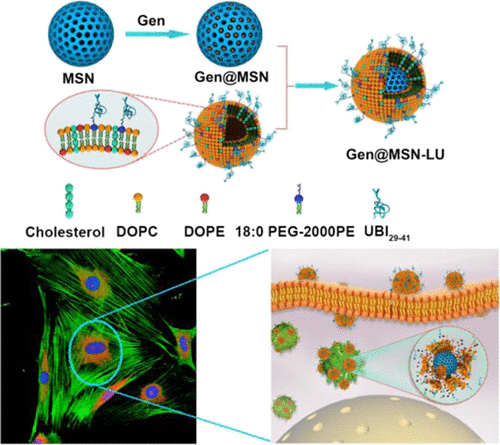当前位置:
X-MOL 学术
›
ACS Appl. Mater. Interfaces
›
论文详情
Our official English website, www.x-mol.net, welcomes your feedback! (Note: you will need to create a separate account there.)
Bacteria-Targeting Nanoparticles with Microenvironment-Responsive Antibiotic Release To Eliminate Intracellular Staphylococcus aureus and Associated Infection
ACS Applied Materials & Interfaces ( IF 9.5 ) Pub Date : 2018-04-10 00:00:00 , DOI: 10.1021/acsami.7b15678 Shengbing Yang 1 , Xiuguo Han 1 , Ying Yang 1 , Han Qiao 1 , Zhifeng Yu 1 , Yang Liu 2 , Jing Wang 2 , Tingting Tang 1
ACS Applied Materials & Interfaces ( IF 9.5 ) Pub Date : 2018-04-10 00:00:00 , DOI: 10.1021/acsami.7b15678 Shengbing Yang 1 , Xiuguo Han 1 , Ying Yang 1 , Han Qiao 1 , Zhifeng Yu 1 , Yang Liu 2 , Jing Wang 2 , Tingting Tang 1
Affiliation

|
Staphylococcus aureus (S. aureus) is a causative agent in life-threatening human diseases that afflict millions of people annually. Traditional antibiotic treatments are becoming less efficient because S. aureus can invade host cells including osteoblasts and macrophages, constituting a reservoir that is relatively protected from antibiotics that can lead to recrudescent infection. We herein report a unique intracellular antibiotic delivery nanoparticle, which is composed of (i) a mesoporous silica nanoparticle (MSN) core loaded with gentamicin, (ii) an infected microenvironment (bacterial toxin)-responsive lipid bilayer surface shell, and (iii) bacteria-targeting peptide ubiquicidin (UBI29–41) that is immobilized on the lipid bilayer surface shell. The lipid material acts as a gate that prevents drug release before the MSNs reach the target cells or tissue, at which point they are degraded by bacterial toxins to rapidly release the drug, thus eliminating efficient bacteria. We confirm rapid drug release in the presence of bacteria in an extracellular model and observe that S. aureus growth is effectively inhibited both in vitro and in vivo of planktonic and intracellular infection. The inflammation-related gene expression in infected preosteoblast or macrophage is also downregulated significantly after treatment by the antibiotic delivery nanoparticles. The antibiotic delivery nanoparticles offer advantages in fighting intracellular pathogens and eliminating the inflammation caused by intracellular bacterial infections.
中文翻译:

具有微环境响应性抗生素释放的细菌靶向纳米颗粒,可消除细胞内金黄色葡萄球菌和相关感染
金黄色葡萄球菌(S. aureus)是威胁生命的人类疾病的致病因子,每年困扰着数百万人。由于金黄色葡萄球菌可以侵入包括成骨细胞和巨噬细胞在内的宿主细胞,从而构成了一个相对较不受可能导致复发性感染的抗生素保护的储库,因此传统抗生素治疗的效率正在降低。我们在此报告了一种独特的细胞内抗生素递送纳米颗粒,该颗粒由(i)装有庆大霉素的中孔二氧化硅纳米颗粒(MSN)核心,(ii)受感染的微环境(细菌毒素)响应的脂质双层表面壳和(iii)细菌靶向肽泛肽(UBI 29–41)固定在脂质双层表面壳上。脂质物质可作为门,阻止MSN到达目标细胞或组织之前释放药物,这时它们会被细菌毒素降解,从而迅速释放药物,从而消除了有效的细菌。我们确认在细胞外模型中存在细菌时药物会快速释放,并观察到金黄色葡萄球菌在体外和体内,浮游和细胞内感染均能有效抑制生长。抗生素递送纳米颗粒治疗后,感染的成骨细胞或巨噬细胞中与炎症相关的基因表达也显着下调。抗生素递送纳米颗粒在抵抗细胞内病原体和消除细胞内细菌感染引起的炎症方面提供优势。
更新日期:2018-04-10
中文翻译:

具有微环境响应性抗生素释放的细菌靶向纳米颗粒,可消除细胞内金黄色葡萄球菌和相关感染
金黄色葡萄球菌(S. aureus)是威胁生命的人类疾病的致病因子,每年困扰着数百万人。由于金黄色葡萄球菌可以侵入包括成骨细胞和巨噬细胞在内的宿主细胞,从而构成了一个相对较不受可能导致复发性感染的抗生素保护的储库,因此传统抗生素治疗的效率正在降低。我们在此报告了一种独特的细胞内抗生素递送纳米颗粒,该颗粒由(i)装有庆大霉素的中孔二氧化硅纳米颗粒(MSN)核心,(ii)受感染的微环境(细菌毒素)响应的脂质双层表面壳和(iii)细菌靶向肽泛肽(UBI 29–41)固定在脂质双层表面壳上。脂质物质可作为门,阻止MSN到达目标细胞或组织之前释放药物,这时它们会被细菌毒素降解,从而迅速释放药物,从而消除了有效的细菌。我们确认在细胞外模型中存在细菌时药物会快速释放,并观察到金黄色葡萄球菌在体外和体内,浮游和细胞内感染均能有效抑制生长。抗生素递送纳米颗粒治疗后,感染的成骨细胞或巨噬细胞中与炎症相关的基因表达也显着下调。抗生素递送纳米颗粒在抵抗细胞内病原体和消除细胞内细菌感染引起的炎症方面提供优势。



























 京公网安备 11010802027423号
京公网安备 11010802027423号